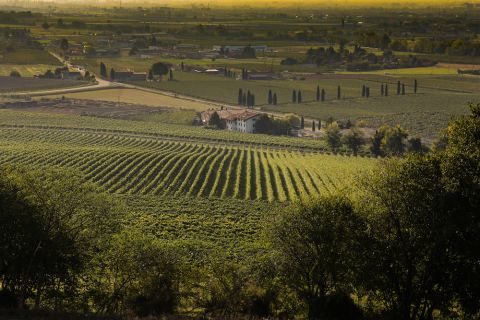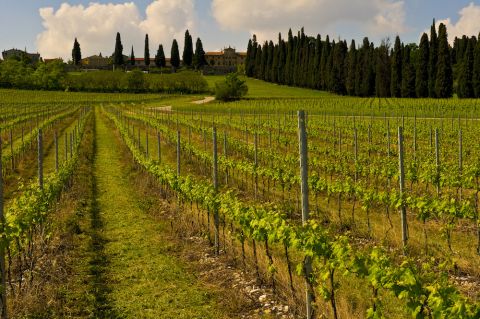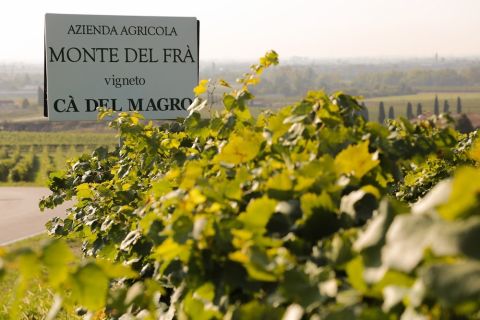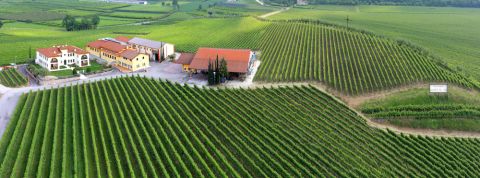From €7.20, 1,386 Japanese yen, 45 Polish zloty, 12 Swiss francs, £10.75, $13.99, 269 Czech koruna, 159.90 Norwegian kroner
Find the Monte del Frà Custoza
From €9.90, 55 Polish zloty, HK$99, 201.33 Swedish kronor, 164.90 Norwegian kroner, 2,156 Japanese yen, 15.90 Swiss francs, £15.59, $19, 195.09 Brazilian reais
Find the Monte del Frà Cà del Magro Custoza Superiore
Marica Bonomo warns us, halfway through an online tasting of her family’s Veneto wines, that ‘as you can see, I have the attitude to talk, even if my English is not 100% percent, so you must interrupt me’, and then she chatters on, nonstop. Uninterruptible. Everything on emphasis, every second word in italics. But then, you wouldn’t really want to interrupt her – listening to her is like drinking from a mountain stream. Bubbling with genuine enthusiasm and pride in the estate established by her grandfather Massimo Bonomo in 1958, she must surely be the poster child for Custoza, the Lake Garda wind-blown, morainic DOC within which Monte del Frà is at the very heart.
In 2021, Walter wrote about Custoza – a rising white wine star, and with his usual (unjustified) self-deprecating honesty, admitted that while he aims for in-depth knowledge of every Italian wine region, ‘poor Custoza was very low on my to-do list. I couldn’t really imagine that the Custoza blend, consisting of at least 70% of Garganega, Cortese and Trebbianello (aka Friulano), with lethally boring Trebbiano Toscano on stand-by, could be of more than marginal interest.’ A delivery of Custoza samples totally changed his mind.
He writes beautifully, in detail, about the story, soils and character of Custoza (despite the comment about the ‘lethally boring’ Trebbiano Toscano, which cracked me up), so I would urge you to read the article, at the same time as I urge you to try not one but two of these under-appreciated white wines that Walter describes as ‘punch[ing] well above their weight at astonishingly modest prices’.
While the Bonomo family make wonderful Chiaretto rosé, Bardolino and some of the freshest, most elegant Valpolicella wines I’ve tasted, it’s their two Custoza wines that I want you to know about.
The first is their ‘calling card’ wine, as Bonomo puts it, made from roughly 45% Garganega, 35% Cortese and 20% Trebianello and Trebbiano. ‘Our Garganega is very gentle, white flowers, and our Cortese is very perfumed – I call it our Chanel No 5’, she says. Between the JR.com team members, we’ve tasted eight vintages of this ridiculously under-priced wine and all of us have sung its praises. It’s absolutely every single thing you could possibly ask for in an ‘everyday’ wine. It’s sunlight bright with flowers and fruit. The acidity is nervy and quicksilver and energetic and yet (for those who are not acid freaks) it also has a kind, smudgy softness. If there is a bite to the wine (it’s Italian – of course there’s a bite), it’s more of a gentle nibble that has the sweet bitterness of Seville orange pith and apricot kernels. It has mouth-watering salinity and although it is chiselled by freshness, there is a depth to it. That this wine is only 12.5% alcohol and averages out at £10 a bottle is simply crazy. There are wines twice, thrice the price and half as good. I’ve just a few days ago tasted the 2022 which is not yet released, and it is so good that I wanted to go running down the road to tell random strangers about it. But the great thing about this wine is that the previous vintages are every bit as good, and it’s not a wine that has to be drunk young. We’ve been conservative with our recommended drinking dates but I’m fairly confident that you could be drinking this back to 2018, or even 2017.
The second wine is Monte del Frà’s single-vineyard Custoza. Called Cà del Magro, it’s from their own vineyard in the heart of the village and planted with a field blend of 55-year-old vines: Garganega, Trebbiano Toscano, Cortese, Incrocio Manzoni. They vinify with skin contact and age the wine in concrete tank. Bonomo’s dark eyes widen as she tells us: ‘You would be shocked at how well it ages’.
It’s quite difficult to describe just how beautiful this wine is, from the first moment. Beautiful, complex, and (in the way the best wines do) constantly changing. It’s a wine that pulls off that rare coup of being all things in perfect balance. The perfume, which soars out the glass without a moment’s hesitation, has a spring-like delicacy but a summery confidence. Our crocuses and daffodils are just coming through, and yesterday I went to check that I wasn’t imagining things: nope. This wine smells of daffodils, crocuses, snowdrops. The fruit is warm-climate abundant, tropical and lush. Think mangoes. The acidity is an element you’re going to feel at the top of your spine, a tingle in the back of your neck more than something you’ll hold in your mouth. Its texture reminds me of handmade paper – rough-smooth; something you want to rub between your fingers. It’s long. It will age, possibly for more than a decade.
As with the ‘straight’ Custoza, there really isn’t an issue around vintages. We’ve been raving about this particular wine since the 2013 vintage. You could buy a case of the 2021 (which is what I most recently tasted) and drink a bottle a year and I’d put money on the prediction that every time you taste it, the wine will be glorious. In fact, I’d like nothing better than to taste a vertical of this wine. It is worth way more than twice the price it commands. Sip for sip, it’s even more insanely under-priced than their estate Custoza.
Food pairing? Anything. Really. Both wines have the mettle, depth, breadth and vitality, but also, most importantly, dignified grace, to pair with pretty much anything. I say ‘dignified grace’ because these are not shouty, showy wines that will overshadow delicate dishes. At the same time, they have the gumption to hold their own with shouty, showy food. You could pair these wines across the spectrum, from ceviche to steak. I recently had a meal with the most beautiful roast venison, and I wish I could have tried this wine with it. I’m willing to bet good money it would have outstripped the red wines we had on the table. There are few wines, red and white, I can think of which could be this catholic and generous when it comes to food.
On the sustainability front, although Monte del Frà is not certified organic, they have farmed without pesticides and herbicides for years, use drip irrigation (which, they’ve calculated, has reduced water usage by 70%), and they’ve recently obtained the SQNPI (National Quality System for Integrated Production) and RRR (Reduce, Retrench, Respect) certifications. They have just begun an extensive renovation of their winery, using locally sourced materials, which will see solar panels providing 100% of their energy requirements and a waste-water plant recycling all their water.
From 2022 they have started to radically reduce their bottle weights. The challenge, Bonomo tells us (with a dramatic gesture of despair), is that ‘us Italians love fancy things!’ To persuade their markets, especially the Italian one, to accept lighter, smaller bottles is a hard enough task. To persuade the bottle supplier to source lightweight bottles is an even tougher task. As for screwcaps for the Italian market … she rolls her eyes to the sky. I am reminded of something she said earlier when talking about climate change: ‘So, we pray a lot and use our crazy and our love.’
I can’t think of a better way to wrap up. Pray. Use your crazy. Love.
These two wines can be found in Austria, Belgium, Brazil, Cyprus, Estonia, Finland, Italy, Germany, Hong Kong, Japan, Lithuania, Netherlands, Norway, Poland, Romania, Sweden, Switzerland, UK, USA (IL, MD, MO, NY, TX).
Want more recommendations like this? Become a member to access the 230,000+ wine recommendations in our database.





















